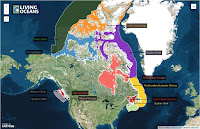Today, on Oceans Day, I invite you to think about your connection to the ocean. Everyone has a connection to the ocean. For me the ocean is deep—in more ways that one! When I was in my early twenties and lived close to beach, a solo walk along the seashore would allow me to revel in my emotions—which were dynamic, intense, pushing and pulling me one way and another. Perhaps the action of the waves soaked up some of the intensity (as I said, I was in my early twenties) and I felt able to carry on.
These days I think my connection has a much more scientific edge to it (this is safer territory). I know that Canada’s ocean ‘estate’ is roughly 70% as big as its land-based estate. As Canadians, we can certainly be proud of the magnitude of our oceans and the awe inspiring seascapes that surround our country. No matter where we live in Canada, rivers and waterways connect all our homes to one of Canada’s three oceans.
Now take a deep breath and say a word of thanks to the ocean. Every other breath you take comes from the ocean because the oceans’ plants produce half of the world’s oxygen. That’s a pretty necessary connection for all of us. How do we ensure this connection persists and our oceans stay healthy? One way is through Marine Protected Areas (MPAs). MPAs are ocean places that are set aside like parks, providing sanctuary for individual species and entire food-webs so they can recover and thrive. They’re like an insurance policy. Take a moment to tour a few protected areas (one in each province) that showcase some of Canada’s spectacular wildlife and connect us to the oceans. Revel in the beauty, feel the pride; after all, it’s Oceans Day!
Currently, only 3.4% of the global ocean is in protected areas, compared to 15.4% of the world’s terrestrial and inland water areas. However, it’s higher (8.4%) if you consider only marine areas within national jurisdiction (e.g., exclusive economic zones)1. When we look at Canada’s record, we get a bit of a shock – less than 1% of Canada’s oceans are protected. Still proud of Canada? Browse through our new maps to see all the MPAs or check the protection status for each of Canada’s 12 marine bioregions.
What about connections between protected areas? That’s the way to really make protected areas efficient; build a network. In 2011, Canada released a National Framework for Canada's Network of Marine Protected Areas, a document to guide design of networks of MPAs. That was four years ago, and guess where all the newly designed networks are? Nowhere. That’s right, no networks completed yet. Where’s your sense of pride now?
A few days ago, Living Oceans along with five other conservation organizations, delivered a set of MPA recommendations to every single Member of our Parliament. We are urging the federal government to step up the pace on marine protection. This Oceans Day, please take action and add your name to the list of those who support a more robust insurance policy for our oceans.
1. These stats come from the Protected Planet Report of 2014 from the United Nations Environment Programme World Conservation Monitoring Centre (UNEP-WCMC), so I trust them.




No comments:
Post a Comment